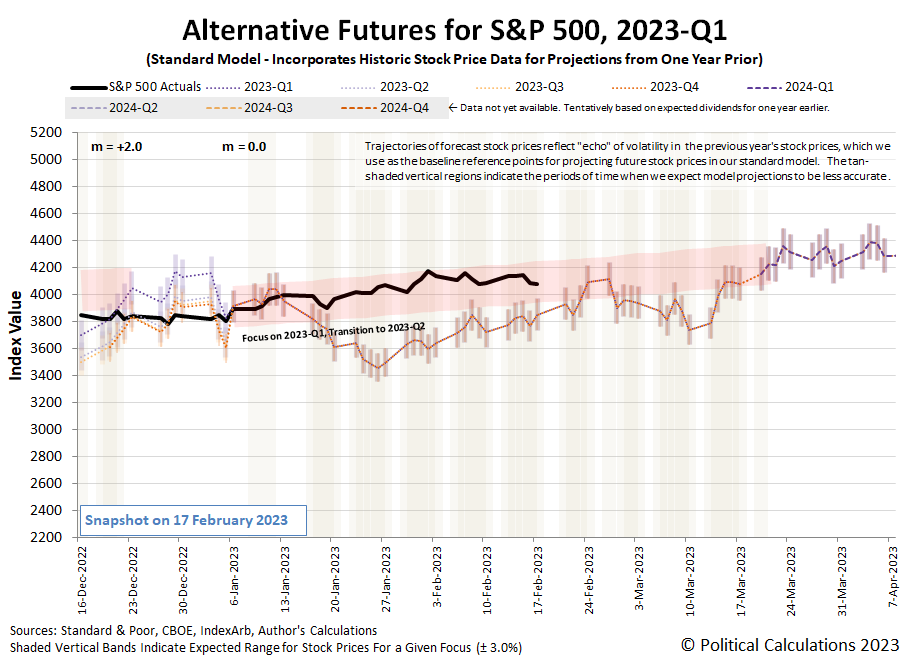The S&P 500 In A New Market Regime?
The S&P 500 retreated 0.3% from the previous week's close to reach a value of 4079.09 during the trading week ending on Friday, February 17, 2023. That puts the index 15% below its record high peak of 4,796.56 set back on January 3, 2022.

Picking up where we left on in last week's analysis, we've modified our assessment for when the latest shift in the dividend futures-based model's multiplier occurred. We're now looking at Friday, 6 January 2023 as the date marking when the multiplier changed from +2.0 to roughly zero, based on how stock prices behaved in the weeks leading up to and in the weeks since that date.
The latest update to the alternative futures chart shows how it looks after updating it to account for the apparent change in market regime at that time.

The question now is what changed around that time to cause the change in market regime?
The need to periodically have to answer questions like this is why we make a point of documenting the market-moving news headlines of the week. Here are the previous editions of our ongoing S&P 500 chaos series that overlap this period. Here are the relevant editions:
- The S&P 500 Ends 2022 Back in Bear Territory (Trading week ending 3 January 2023)
- 2022's Volatility Continues Into 2023 for the S&P 500 (Trading week ending 10 January 2023)
- Brightening Outlook for 2023 Dividends Boosts S&P 500 (Trading week ending 17 January 2023)
The biggest potential needle mover we see in the headlines over this period is the end of the Chinese government's zero-COVID lockdowns following popular protests. Given China's role as a major producer of goods consumed in other countries and the economic disruption its failed three-year old policy was having on global supply chains, the sudden change in its government's policy would have global impact as details of the lifting of its lockdowns became known. Much like how the onset of 2020's coronavirus pandemic initially triggered the first change we ever observed in real time of the dividend futures-based model's multiplier, it would make sense that the end of the Chinese government's economically destructive COVID response would be accompanied by another shift in the multiplier.
Before we move onto other topics, what we've just described is a working hypothesis that may be adapted or even dropped as we get more and better information. Stock prices are influenced by a lot of moving pieces and there are many other factors that are also at work at any given time. To filter through the noise to develop this hypothesis, we're not just looking for the potential to cause a change in market regime, but also for factors that aren't regularly present in the market because historical data suggests such regime changes do not happen often. We think any successful competing hypothesis would have to likewise meet that requirement.
One way we can check the hypothesis is to see what happened with expected future dividends in response to the new information. Positive dividends would be expected to arise from the end of China's zero-COVID lockdowns and their disruptive effect on supply chains. And quite literally, they have. As touched on in the older editions of the S&P 500 chaos series highlighted above, the outlook for the S&P 500's dividends have brightened considerably in the weeks since the market regime changed. We'll take a closer look at when and how much they changed later this week.
More By This Author:
China's Zero-Covid Lockdowns Slow Pace Of CO₂ Accumulation In Atmosphere
When Will The Inflating Price Of Eggs Break?
Is The S&P 500 Running Hot Or Are Other Factors At Work?
Disclosure: Materials that are published by Political Calculations can provide visitors with free information and insights regarding the incentives created by the laws and policies described. ...
more


